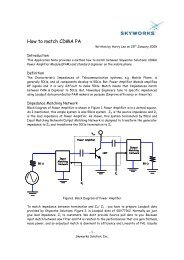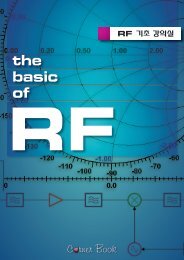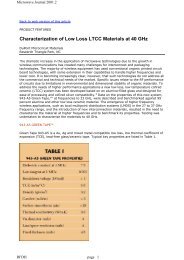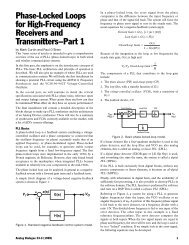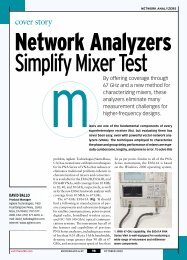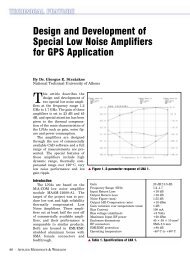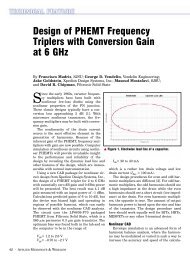Mathcad - ee217projtodonew2.mcd
Mathcad - ee217projtodonew2.mcd
Mathcad - ee217projtodonew2.mcd
Create successful ePaper yourself
Turn your PDF publications into a flip-book with our unique Google optimized e-Paper software.
Introduction<br />
Low noise amplifiers are useful for a variety of applications, where small signals are received.<br />
This report is written specifically for the application in a IS-95B cellular telephone handset. The<br />
routines developed to design an analyze the amplifier are organized in a way so that the design<br />
process is completely automated after entry of the process parameters and high level system<br />
specifications. Also the procedure is general purpose that keyu equations can be replaced so the<br />
routine is suitable for other configurations and devices, such as GaAs and MOSFETs. After the<br />
<strong>Mathcad</strong> automated design is complete, the results are used as a starting point for simulations on<br />
a commercial simulation tool. The graphs of performance parameters as a function of device size<br />
and current serve as a guideline for the iterations of simulations. The final simulated results for<br />
amplifier are summarized and conclusions are made.<br />
The low noise amplifier designed for this project is part of a larger project. The specifications<br />
for the amplifier were developed for use in the handset of a 1900MHz CDMA cellular telephone.<br />
The actual specifications involve trade-offs with blocks which occur later in the receiver chain. A<br />
collection of more than 16 impedance matching routines were also developed in previous project<br />
unrelated to the system analysis. These collection of routines are easily available on the<br />
following website: http://www.eecs.berkeley.edu/~wetherel/rftoolbox/matcher.html. The<br />
system analysis and the impedance matching network design routines were used as a<br />
foundation for the automated low noise amplifier design tool.<br />
An interesting comment on the report for this project is that it is written entirely in <strong>Mathcad</strong>, a<br />
tool for simultaneuous word processing and mathematics computation. This combination of<br />
features makes the report a "living" document. With a few clicks the reader can modify the LNA<br />
design for his/her specific system and process specifications. In a world where processes<br />
change every few years and new specifications are needed just as often the design automation of<br />
LNAs is a very useful feature. The use of <strong>Mathcad</strong> also allowed the rapid entering of design<br />
equations from available books on radio frequency circuit design. These equations include those<br />
for simultaneous conjugate impedance matching [ ] and distortion analysis of common-emitter<br />
amplifiers [ ].






